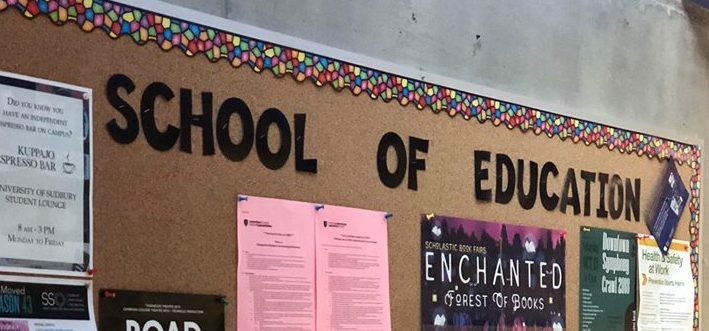by Alyssa Boudreau
Over the summer, Premier Doug Ford repealed the 2015 sex education curriculum and replaced it with the 1998 outdated version. Teachers were even warned that they could face consequences if they continue to teach the 2015 curriculum.
Returning to the 1998 sex education curriculum cuts out the teaching of consent, digital communication, same sex relationships, and gender identity. This poses potentially dangerous problems for our youth and next generation, particularly the LGBTQIA2S+ community.
Lee Czechowski, first-year Liberal Science student, said they “think that the change in the sex ed curriculum is just going to breed more ignorance, more homophobia, more transphobia, and more racism.”
“Basically, the kids who are queer are just going to be shoved further into the closet, and the kids who aren’t queer are going to perpetuate heteronormative, cisnormative, settler ideologies” Czechowski said.
“Without the introduction to and normalization of the spectra of gender and sexuality, queer kids are going to feel ostracized, abnormal, and ashamed, which is a recipe for mental illness and suicidality.”
Professor of Women’s, Gender, and Sexuality Studies, Laurie McGauley, said “that the old sex ed curriculum has huge gaps, which is why it was replaced.”
“One of the major problems with the old curriculum is the absence of any notion of consent. As we know, this is dangerous.”
“Children need to learn and develop the skills to assume that their consent is necessary before anyone can touch their bodies, as well as the understanding that they need to get consent before touching anyone else. The fact that these basic lessons are not being taught to our children puts them at risk” McGauley said.
Ryan Wildgoose, Co-Director of Pride Laurentian, the Sexual and Gender Diversity Commissioner of the Graduate Students Association, and a member of Fierté Sudbury Pride is currently doing Ph.D. research on “the role of sexual orientation in the classroom – including sex education – within early-twentieth century Ontario schools”.
Wildgoose’s research focuses on “the importance of a queer-friendly sexual education curriculum that can, by promoting inclusivity and understanding, potentially reconstruct the way people view non-heterosexuality and progress toward a more inclusive future”.
As a member of the LGBTQIA2S+ community himself, Wildgoose admits that being taught under the 1998 sex education curriculum had lasting negative effects on his mental health.
“[I] received no education regarding sexual orientation or gender identity,” Wildgoose said.
“My mental health has suffered for more than half of my life because I didn’t understand who I was or why I didn’t seem to feel comfortable with the way society wanted me to be, and it wasn’t until my mid-twenties that I discovered the answers.”
When the 1998 sex education curriculum was written, same-sex marriage was not yet legal in Canada, and wouldn’t be for another 7 years.
“As a result, the 1998 curriculum does not cover any information regarding same sex relationships, and pushes a heteronormative agenda,” Wildgoose added.
“The representation of sexual orientation in the curriculum is important for the youth who are figuring out their sexuality either as children or adolescents, not only in helping them realize that there is nothing wrong with them, but in allowing the people around them to recognize that same fact.”
Along with sexual orientation, gender identity will no longer be taught in the sex education curriculum.
Wildgoose pointed out that people fear that the teaching of gender identity is “encouraging [children] to ‘become transgender’”, when in reality it helps students “understand themselves, and respect the world around them, whether they be classmates, friends, family members, or members of the community that they pass on the streets”.
Gender identity was added to the provincial Human Rights Code in 2012, and the national Human Rights Act in 2017.
The Ford government commented that it should be up to parents to teach their children about the subjects no longer included in their sex education curriculum at school.
“Most parents are not up-to-date enough in order to provide this education” Wildgoose said.
“Curricula exist so that children and adolescents can receive an education from professionals on topics that their parents may not be able to teach properly. So why should sex education be any different?”
Wildgoose pointed out that while some parents are simply uneducated on the subject, some are just unwilling to teach it.
“My parents never taught me anything about the LGBTQIA2S+ community growing up. Due to a cisnormative and heteronormative society, it simply never crossed their minds.”
“This situation is particularly personal to me, not only as a large portion of my doctoral research, but as a member of the LGBTQIA2S+ community” Wildgoose explained.
“Although my mental health has improved, I am still experiencing the after-effects of this. Many LGBTQIA2S+ youth have similar experiences, even if the details are altogether different.”
Wildgoose is heavily involved in the LGBTQIA2S+ community, which is his “attempt to help others who may feel lost and alone but providing them with knowledge, resources, and representation”.
The Pride Centre, room P-221, is a campus designated safe-space.
